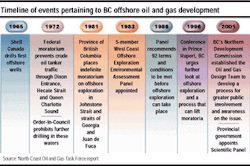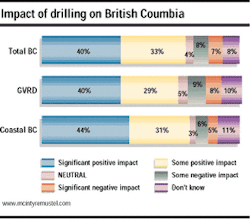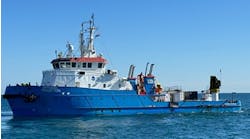The Geological Survey of Canada places oil reserves offshore British Columbia in the neighborhood of 9.8 billion bbl, and natural gas at 25.9 tcf. These reserves are 10 times greater than estimates for the Hibernia Field, one of the largest discoveries in the Jeanne d'Arc Basin offshore Newfoundland, on Canada's Atlantic coast.
The potential gross revenues over time for reserves offshore British Columbia are US$187.2 billion in oil and US$3.3 billion in natural gas, with estimates hovering around US$2.6 billion per year in revenue for the province.
The problem is getting the oil and gas out of the ground. A moratorium that has been in place for nearly 30 years prohibits offshore exploration and production.
The area under moratoria lies northwest of Vancouver Island and includes the Johnstone Strait, the straits of Georgia and Juan de Fuca (covered by a provincial government moratorium), Hecate Strait, and Queen Charlotte Sound (covered by a federal government moratorium and a subsequent federal Order-In-Council indefinitely prohibiting exploration and drilling).
In recent years, the Province of British Columbia has suffered with the decline in the timber, fisheries, and game industries. And the significant dent in the economy has turned attention to the resources lying offshore. Revenues from oil and gas could change the economic tenor of the province. And a ready hydrocarbon market in the US can hardly hurt the situation.
What was unthinkable only a few short years ago is beginning to look appealing. Though conservative estimates indicate it could take up to a decade to put the first rigs in place, there is now a possibility of offshore oil and gas exploration where none existed before.
US turns to Canada
Recent news out of Washington clearly indicates that America is looking to Canada in a move to secure a steady non-OPEC oil supply. President George W. Bush has stated America's goal of reducing US dependence on overseas sources of oil. Also, the administration has publicly announced its intention to be proactive in developing Canadian natural resources, an initiative Canadians are referring to as the "Bush Push."
If the US is serious about making the move to create a North American perimeter of protection, Canada will undoubtedly play a major role. The importance of increasing the oil and gas supply from Canada is critical, and more areas are likely to open up to exploration following the announcement of the new US policy.
Already, US companies are making sizable company and reserves acquisitions north of the border. A recent Energy Power Systems Ltd. report cites three huge American acquisitions of Canadian companies that took place in September and October of this year:
- Devon Energy purchased And- erson Exploration for US$4.6 billion
- Duke Energy purchased Can-ada's Westcoast Energy for $3.5 billion
- Burlington Resources purch-ased Canadian Hunter for $3.3 billion.
Forum review
The recent flurry of acquisition activity coincided with a forum October 2, in Vancouver, British Columbia, to address the possibility of lifting a provincial level moratorium that has prevented offshore drilling for nearly 30 years. The purpose was to discuss critical steps required in the public process to open the area. The conference, The Dawning of a New Era: The Future of Offshore Oil and Gas in British Columbia, organized by Western Policy Consultants, was attended by environmental and local community groups, industry, representatives of the Canadian government, and First Nations organizations (equivalent to Native Americans' groups in the US), among others. The subjects addressed included the international offshore resource development experience, provincial government plans and initiatives, the current federal government environment, environmental issues, aboriginal rights and First Nations offshore issues, industry perspectives, coastal community concerns and opportunities, and economic impacts.
Greater Vancouver Regional District (GVRD) is the large metropolitan area that includes the City of Vancouver and all communities in the vicinity. The population (about 1.5 million) represents about half of the population of the province.
McIntyre and Mustel Research Ltd. was commissioned to assess public opinion in British Columbia about opening up the offshore area to oil and gas exploration. Poll results showed that British Columbians support offshore oil and gas exploration and drilling by a margin of two to one if they can be assured that there is limited environmental risk. "Support rises in relation to socio-economic benefits and falls in relation to some environmental impacts," said Barb Justason, a partner with the company.
"The poll results strongly support the British Columbia government's decision to review the existing moratorium. Public opinion has clearly shifted in favor of allowing responsible exploration of oil and gas off the coast of British Columbia," said Patrick Hrushowy, Energy Practice Chair at Western Policy Consultants.
First Nations' position
Miles Richardson, Chief Commissioner of the British Columbia Treaty Commission, has been working with First Nations groups to establish government-to-government treaties that outline First Nations' rights. His participation in the conference was primarily to clarify that critical matters are being addressed at the negotiating table.
One of the conditions for agreement to develop offshore reserves would be reaching a treaty agreement on all of the issues involved. That means that the First Nations groups need to be recognized and their jurisdiction over the area in question established. Richardson said the need to achieve jurisdictional clarity and certainty must come first. Going along with opening up the offshore area is "a function of recognition of First Nations' rights," he said.
When that has been achieved, Richardson said, the First Nations groups would be open to discussing anything. Until that happens, however, it is going to be very difficult to have a context for discussing the subject. In Richardson's opinion, the current climate in the province could move things forward. The need for oil might speed up development, he said.
Scientific committee
A change in the provincial government earlier this year breathed fresh air into the moratoria issue. In mid-October, the provincial government appointed an independent scientific review panel that will examine whether offshore oil and gas resources can be extracted in a way that is scientifically sound and environmentally responsible.
The panel is made up of academicians from local universities. Their first task was to review a report on offshore development technologies that was prepared by Jacques Whitford Environ-ment Ltd. and considers scientific and technological advancements, changes in regional economics, and developments in other jurisdictions. The panel is responsible for assessing the environmental risks of developing massive offshore energy reserves. When all of the information has been reviewed, the panel will make an environmental assessment based on the facts at its disposal and will submit a report to the provincial government by January 2002.
Offshore reserves
British Columbia could well follow the lead of the Maritime Provinces on Canada's east coast. The Hibernia project offshore Newfoundland/ Labrador was launched in the late 1980s, followed shortly thereafter by the Terra Nova project. The Sable offshore energy project off Nova Scotia got started in the 1990s.
Nova Scotia and Newfoundland/Labrador have employed state-of-the-art technology for exploration, drilling, and environmental assessments with great success. And the provinces are already seeing the benefits of offshore development. These provinces share a similar history with British Columbia, having been built on the fishing industry, so environmental concerns were a primary issue when the provinces determined to exploit their offshore reserves.
Additional offshore obstacles had to be taken into account offshore Newfoundland/Labrador, where the threat of iceberg damage had to be considered along with other environmental issues. Technology has risen to the challenge these obstacles present. The Terra Nova floating, production, storage, and offloading (FPSO) unit, for example, is especially designed for work in the North Atlantic.
The vessel has a spider buoy that allows it to disconnect in about 15 minutes in case of emergency. And it is double hulled to withstand potential iceberg impact up to 100,000 tons. Proponents of offshore drilling off British Columbia point to these achievements when concern for the environment surfaces. The belief is that where there are environmental concerns, technology can supply a work-around.
Industry position
Three companies still hold licenses for acreage offshore British Columbia. Chevron, Petro-Canada, and Shell all own the rights to explore and develop their holdings should the ban on offshore drilling be lifted. None of these companies was represented at the latest conference convened to address lifting the moratoria.
According to Pierre Alvarez of the Canadian Association of Petroleum Producers in Calgary, Alberta, industry's interest is pending. One of the reasons, in his opinion, is that a number of things need to be established before industry becomes involved in this latest move toward lifting the moratoria. These include:
- Clear and certain regulatory environment for the offshore - who is in charge, in terms of jurisdiction
- Under what regulatory framework environmental assessment work would be done?
- Determining if offshore development meets with the interests, desires, and support of people in British Columbia and from First Nations groups.
"Until those three are met, it is very difficult for industry to be spending either time or resources in the offshore," Alvarez said. From an industry point of view, the ball is entirely in the government's court. In the end, the government of British Columbia will decide whether and in what manner activity will be considered.
British Columbia moratoria history
The first north coast oil and gas exploration began in the early 1900s. In 1959, the provincial government imposed the first moratorium on exploration drilling in coastal waters between Vancouver Island and the border of Alaska and British Columbia. This moratorium was lifted temporarily in 1966 to permit 14 exploratory wells to be drilled.
In 1972, the Canadian government instated a moratorium that prevented crude oil tankers from traveling through the Dixon entrance, the Hecate Strait, and Queen Charlotte Sound. Later the same year, a federal Order-In-Council prohibited drilling and exploration. In 1981, the Province of British Columbia put in place a moratorium on offshore exploration in Johnstone Strait, and the straits of Georgia and Juan de Fuca.
Public opinion polls conducted in 1984-1985 produced 92 recommendations that outlined conditions that would need to be met before development could get underway. The results were intended to aid the provincial government in negotiating a Pacific Accord, which would allow the moratorium to be lifted. A few short years later, the Exxon Valdez spill in 1989 led to an indefinite extension of the moratorium.
Two conferences were held (1996, 1998) in Prince Rupert, British Columbia, to look into ocean business opportunities. Both resulted in an official position in favor of lifting the moratoria on oil and gas exploration. The Prince Rupert-based North Coast Oil and Gas Task Force was formed in 1997 to investigate the potential for hydrocarbon exploration off British Columbia's north coast, with a primary objective of building a case for lifting the moratoria.
In 1999, a resolution of British Columbia's Coastal Community Network advocated further investigation into offshore oil and gas E&P opportunities, and the government's Northern Development Commission hired a consultant to conduct a study into the feasibility of lifting the moratorium. Meanwhile, some First Nations groups, fishing groups, and environmental organizations have organized opposition. According to a source at the provincial Ministry of Energy and Mines, regulatory legislation specifically prohibiting offshore drilling is minimal. However, with all of these moratoria currently in place, any exploration or development of British Columbia's offshore oil and gas reserves is effectively forbidden.






